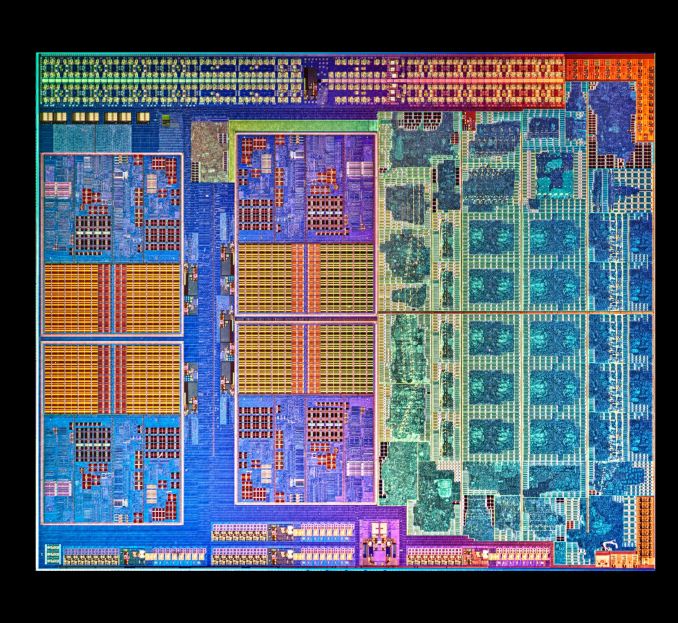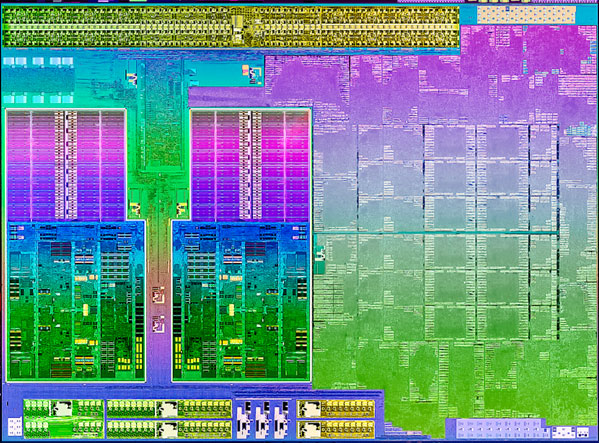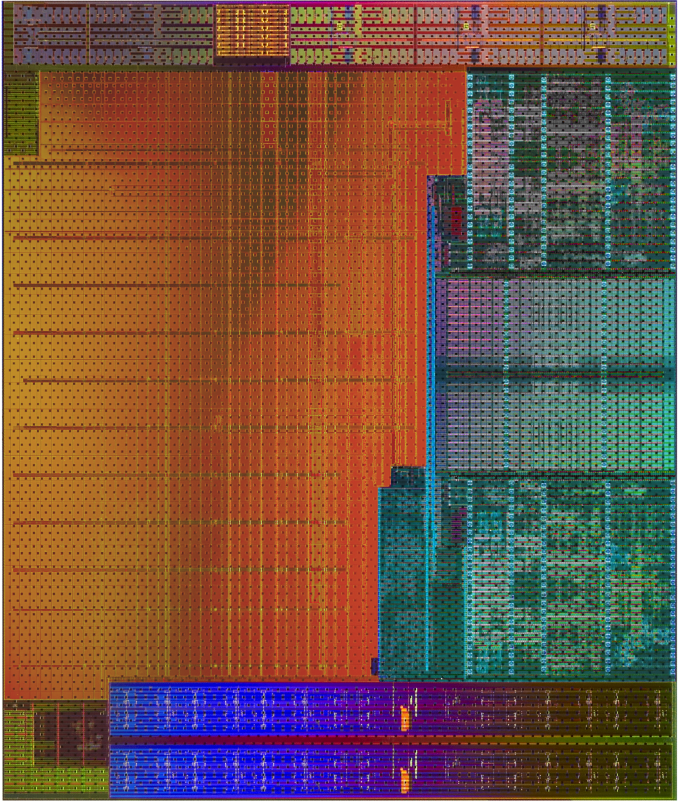AMD Kaveri Review: A8-7600 and A10-7850K Tested
by Ian Cutress & Rahul Garg on January 14, 2014 8:00 AM ESTLlano, Trinity and Kaveri Die: Compared
AMD sent along a high res shot of Kaveri's die. Armed with the same from the previous two generations, we can get a decent idea of the progression of AMD's APUs:
Llano, K10 Quad Core
Trinity and Richland Die, with two Piledriver modules and processor graphics
Kaveri, two modules and processor graphics
Moving from Llano to Trinity, we have the reduction from a fully-fledged quad core system to the dual module layout AMD is keeping with its APU range. Moving from Richland to Kaveri is actually a bigger step than one might imagine:
| AMD APU Details | ||||
| Core Name | Llano | Trinity | Richland | Kaveri |
| Microarch | K10 | Piledriver | Piledriver | Steamroller |
| CPU Example | A8-3850 | A10-5800K | A10-6800K | A10-7850K |
| Threads | 4 | 4 | 4 | 4 |
| Cores | 4 | 2 | 2 | 2 |
| GPU | HD 6550 | HD 7660D | HD 8670D | R7 |
| GPU Arch | VLIW5 | VLIW4 | VLIW4 | GCN 1.1 |
| GPU Cores | 400 | 384 | 384 | 512 |
| Die size / mm2 | 228 | 246 | 246 | 245 |
| Transistors | 1.178 B | 1.303 B | 1.303 B | 2.41 B |
| Power | 100W | 100W | 100W | 95W |
| CPU MHz | 2900 | 3800 | 4100 | 3700 |
| CPU Turbo | N/A | 4200 | 4400 | 4000 |
| L1 Cache |
256KB C$ 256KB D$ |
128KB C$ 64KB D$ |
128KB C$ 64KB D$ |
192KB C$ 64KB D$ |
| L2 Cache | 4 x 1MB | 2 x 2 MB | 2 x 2 MB | 2 x 2 MB |
| Node | 32nm SOI | 32nm SOI | 32nm SOI | 28nm SHP |
| Memory | DDR-1866 | DDR-1866 | DDR-2133 | DDR-2133 |
Looking back at Llano and Trinity/Richland, it's very clear that AMD's APUs on GF's 32nm SOI process had a real issue with transistor density. The table below attempts to put everything in perspective but keep in mind that, outside of Intel, no one does a good job of documenting how they are counting (estimating) transistors. My only hope is AMD's transistor counting methods are consistent across CPU and GPU, although that alone may be wishful thinking:
| Transistor Density Comparison | ||||||||
| Manufacturing Process | Transistor Count | Die Size | Transistors per mm2 | |||||
| AMD Kaveri | GF 28nm SHP | 2.41B | 245 mm2 | 9.837M | ||||
| AMD Richland | GF 32nm SOI | 1.30B | 246 mm2 | 5.285M | ||||
| AMD Llano | GF 32nm SOI | 1.178B | 228 mm2 | 5.166M | ||||
| AMD Bonaire (R7 260X) | TSMC 28nm | 2.08B | 160 mm2 | 13.000M | ||||
| AMD Pitcairn (R7 270/270X) | TSMC 28nm | 2.80B | 212 mm2 | 13.209M | ||||
| AMD Vishera (FX-8350) | GF 32nm SOI | 1.2B | 315 mm2 | 3.810M | ||||
| Intel Haswell 4C (GT2) | Intel 22nm | 1.40B | 177 mm2 | 7.910M | ||||
| NVIDIA GK106 (GTX 660) | TSMC 28nm | 2.54B | 214 mm2 | 11.869M | ||||
If AMD is indeed counting the same way across APUs/GPUs, the move to Kaveri doesn't look all that extreme but rather a good point in between previous APUs and other AMD GCN GPUs. Compared to standalone CPU architectures from AMD, it's clear that the APUs are far more dense thanks to big portions of their die being occupied by a GPU.













380 Comments
View All Comments
nader_21007 - Saturday, January 18, 2014 - link
Can you show me what improvement haswell did over previous gen? TDP going from 77W to 84W, meanwhile performance droped in most cases. Can't you see the charts in this review?Principle - Tuesday, January 14, 2014 - link
Andrew, that depends based on size, budget, etc...and I own an AMD Piledriver CPU and could never tell you when it was supposedly slower, maybe a game takes a couple seconds longer to load, but after that its all the same.And I have used Intel CPUs too, and have hiccups and lag multitasking with them in real life, that never happens on my AMD systems. If you get an i5 and an AMD GPU, that would be great and last with the GPU compute advantage of AMD GPUs and the Mantle potential.
These Kaveri have a lot of value at launch for the entertainment center PCs, or ITX platforms because at 65W or even 45W it delivers a lot of performance in one chip that you can keep cool and quiet in a small package. Also good for all in one PCs built into the monitor. Not for the avid gamer right now, but a little more future proof than an Intel CPU in my opinion.
ImSpartacus - Thursday, January 16, 2014 - link
If you're not gaming, is it really that hard to "future-proof" your CPU?I feel like most low end CPUs will perform "basic" non-gaming tasks for many years to come.
andrewaggb - Tuesday, January 14, 2014 - link
To be clear, I'd get an i5 quad core with a 260x or 270x. I realize they aren't at all in the same price range, but it's good performance per dollar.I was expecting Kavari to have 10% better cpu performance and 25% better gpu performance. This has equal cpu performance and essentially equal gpu performance. It has other improvements, but that's a serious dissappointment on the performance side of things.
I've already got 3 i5 quad cores with a 6870, 7850, and 270x in each and I'm happy with them. Just though Kaveri might be good enough, and it is for older stuff and minecraft and whatnot.
But it seems like yet another year that paying the extra money and having some longevity is going to be the right move.
Quite frankly my oldest system, the i5 750 with a 6870 would mop the floor with kaveri in everything but power consumption.
yankeeDDL - Wednesday, January 15, 2014 - link
You're kidding right?It practically doubled the performance per watt of Richland (45W Kaveri almost always outpaces 100W Richland) and that's disappointing?
It's true that Richland was way behind, but the improvement is massive.
There's still a glaring gap with Intel's CPU, but it is smaller.
Just as much as the glaring gap on the GPU side (but this time on AMD's favor) got wider.
HSA is the key for AMD to push the GPU advantage over to the CPU to compensate. If it works, then Kaveri will be really up to, or better of the core I5 which cost more than 2X ... "IF" ...
Jaybus - Thursday, January 16, 2014 - link
I'm not convinced HSA is the future. It is a diminishing returns issue. The only difference between HSA and SMP is different types of cores are being used. The bus arbitration and coherency issues are exactly the same. Neither is scalable to dozens of cores, let alone hundreds. HSA has the same limitations as SMP. Something like Knights Corner's ring bus and message passing is more likely the future. Near term, there is an advantage to HSA. Long term will rely on a much faster chip-to-chip interconnect to transfers and segmented memory to avoid the arbitration and coherency issues. CMOS silicon photonics maybe. That would enable optical busses orders of magnitude faster than PCIe, or in fact much faster than any chip-to-chip electronic bus, and that would make something like Knights Corner's ring bus the future path to high core counts.jimjamjamie - Thursday, January 16, 2014 - link
A genuinely interesting and insightful comment, thanks.artk2219 - Tuesday, January 14, 2014 - link
Until you play a game that uses more than 2 threads, or have tasks running in the background while gaming, then you'll wish you had those two extra threads. Seriously I wish people would quite trying to recommend dual cores for gaming or even general use, unless its in a machine for the type of person that only does one or two things thing at a time. Dual cores are showing their age now, its only going to be worse a year or two from now. Also why would you spend 90 on a Pentium dual core when you could spend 80 on an Athlon 750k or that same 90 on a 760k. They have similar single thread performance and stomp the g2120 in multithreaded situations, plus they're unlocked so you can overclock to your hearts content. Im not saying that Kaveri isn't overpriced right now, they could stand to drop 20 dollars for the top two chips and 10 for the last chip reviewed. But they just launched and those prices will change, and in the end its easier to point people to one part for all of their needs than it is to point them to two.http://www.newegg.com/Product/ProductList.aspx?Sub...
Nagorak - Wednesday, January 15, 2014 - link
The Intel processors are more energy efficient. That's one reason.artk2219 - Wednesday, January 15, 2014 - link
Fair enough, but its a negligible difference once you factor in the discrete GPU that you would be pairing it with anyways. Cooling it shouldn't be anymore of a problem than cooling the same setup with the DGPU, granted there aren't really any fm2+ itx boards so that may be a problem if you're going for a tiny size, but thats about it.